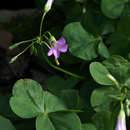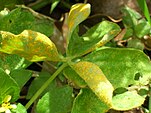en
names in breadcrumbs


Planhigyn blodeuol collddail yw Suran oddfog sy'n enw benywaidd. Mae'n perthyn i'r teulu Oxalidaceae. Yr enw gwyddonol (Lladin) yw Oxalis debilis a'r enw Saesneg yw Large-flowered pink-sorrel.[1] Ceir enwau Cymraeg eraill ar y planhigyn hwn gan gynnwys Suran Oddfog.
Gellir adnabod y planhigyn hwn oherwydd ei ddeilen hollt, sy'n agor yn ystod y dydd ac yn cau dros nos.
Planhigyn blodeuol collddail yw Suran oddfog sy'n enw benywaidd. Mae'n perthyn i'r teulu Oxalidaceae. Yr enw gwyddonol (Lladin) yw Oxalis debilis a'r enw Saesneg yw Large-flowered pink-sorrel. Ceir enwau Cymraeg eraill ar y planhigyn hwn gan gynnwys Suran Oddfog.
Gellir adnabod y planhigyn hwn oherwydd ei ddeilen hollt, sy'n agor yn ystod y dydd ac yn cau dros nos.
Oxalis debilis, the large-flowered pink-sorrel[2] or pink woodsorrel,[1] is a perennial plant and herb in the family Oxalidaceae.[1] Its original distribution is South America but has become a very cosmopolitan species, occurring in all continents except Antarctica. It can be found in both temperate and tropical areas.[3]
The flowers, leaves and roots are edible. There is concern that the plant should only be consumed in small amounts because it contains oxalic acid that can cause calcium deficiency if eaten in larger amounts.[4] Studies show that this is an exaggerated fear.[5] The leaves have what is considered a zesty lemony flavor.
It is a bulbous plant. The fruit is a capsule. The seeds are projected, with an elastic integument. In Europe the plants are sterile and are propagating only by bulbs.[6]
Research on the naturalizing populations in China show the presence of 2 flower morphs, pollen with low viability and polyploidy.[7]
There are two varieties:
'Aureoreticulata' ('aureo-reticulata') has attractive variegated leaves with flowers that are pinkish purple.[3] This cultivar is also named ‘Gold Veined Oxalis’ (Yellow Vein Oxalis) with attractive yellow vein foliage. The symptom is associated with the presence of a begomovirus. This virus, designated OxYVV, is transmitted by the whitefly Bemisia tabaci.[8]
The Royal Horticultural Society advises that it can be a serious weed.[9]

Puccinia oxalidis is a fungus species in the genus Puccinia. This species is a causal agent of rust on plants in the genus Oxalis.
Oxalis debilis, the large-flowered pink-sorrel or pink woodsorrel, is a perennial plant and herb in the family Oxalidaceae. Its original distribution is South America but has become a very cosmopolitan species, occurring in all continents except Antarctica. It can be found in both temperate and tropical areas.
The flowers, leaves and roots are edible. There is concern that the plant should only be consumed in small amounts because it contains oxalic acid that can cause calcium deficiency if eaten in larger amounts. Studies show that this is an exaggerated fear. The leaves have what is considered a zesty lemony flavor.
Oxalis debilis é uma espécie de planta com flor pertencente à família Oxalidaceae.
A autoridade científica da espécie é Kunth, tendo sido publicada em Nova Genera et Species Plantarum (quarto ed.) 5: 236. 1821.
O seu nome comum é azedinha.[1]
Trata-se de uma espécie presente no território português, nomeadamente em Portugal Continental, no Arquipélago dos Açores e no Arquipélago da Madeira.
Em termos de naturalidade é introduzida nas três regiões atrás referidas.
Não se encontra protegida por legislação portuguesa ou da Comunidade Europeia.
Oxalis debilis é uma espécie de planta com flor pertencente à família Oxalidaceae.
A autoridade científica da espécie é Kunth, tendo sido publicada em Nova Genera et Species Plantarum (quarto ed.) 5: 236. 1821.
O seu nome comum é azedinha.
Oxalis debilis là một loài thực vật có hoa trong họ Chua me đất. Loài này được Kunth mô tả khoa học đầu tiên năm 1822.[2]
Oxalis debilis là một loài thực vật có hoa trong họ Chua me đất. Loài này được Kunth mô tả khoa học đầu tiên năm 1822.